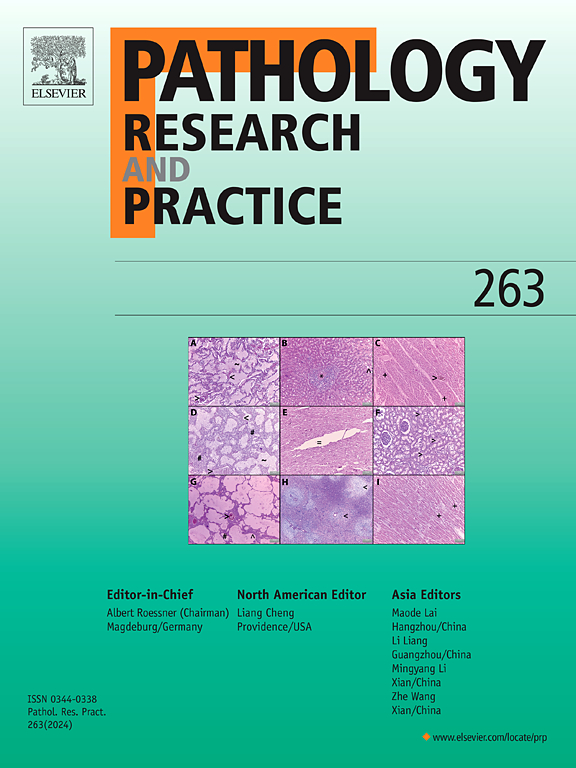Cellular responses to neoadjuvant FOLFOX6-bevacizumab treatment in colorectal cancers analyzed by single-cell transcriptome analysis
IF 2.9
4区 医学
Q2 PATHOLOGY
引用次数: 0
Abstract
Neoadjuvant chemotherapy combined with bevacizumab is used to treat colorectal cancer (CRC) patients by targeting tumor and vascular cells. However, it is known that other cells in the tumor microenvironment (TME) also change in response to this treatment. To investigate the changes in TME subpopulations in response to neoadjuvant FOLFOX6 plus bevacizumab, we studied pre- and post-treatment CRC tissues in four patients using single-cell RNA sequencing (scRNA-seq). This analysis classified nine cell types, including epithelial, vascular, immune cells, and fibroblasts. The cellular responses were widespread across the cell types, but there were specific subpopulations that altered, especially in vascular, immune, and fibroblast cells. In vascular subpopulations, CDH13-endothelial, arteriole, and CA4 capillary cells were selectively reduced. In immune cells, CD4+, CD8+ T cells, conventional dendritic cell type 1 (cDC1), and CCL19-expressing migrating DC (migDC-1) increased, while Th17, Th22, and tumor-associated macrophage (TAM) cells decreased, indicating that the treatment might be immunostimulatory. In fibroblasts, two major cancer-associated fibroblasts (matrix CAF (mCAF) and inflammatory CAF (iCAF)) increased, while conventional fibroblasts decreased, suggesting that the treatment remodeled the reparative/inflammatory processes, which might lead to reduced aggressiveness from the cancer-associated fibroblasts. In summary, our study reveals that neoadjuvant FOLFOX6 plus bevacizumab leads to alterations in particular subpopulations of vascular, immune, and reparative/inflammatory cells in the TME of CRCs. These alterations include vascular reduction, immunologic stimulation, and reduction of cancer-associated fibroblasts, which may underlie the responsiveness to the therapy in CRC. Our results may provide insights into the mechanisms of responsiveness/resistance to neoadjuvant FOLFOX6 plus bevacizumab therapy in CRCs.
通过单细胞转录组分析结直肠癌细胞对新辅助 FOLFOX6-bevacizumab 治疗的反应
新辅助化疗联合贝伐珠单抗通过靶向肿瘤和血管细胞来治疗结直肠癌(CRC)患者。然而,众所周知,肿瘤微环境(TME)中的其他细胞也会因这种治疗方法而发生变化。为了研究TME亚群对新辅助FOLFOX6加贝伐单抗治疗的反应变化,我们使用单细胞RNA测序(scRNA-seq)研究了四例患者治疗前后的CRC组织。这项分析对九种细胞类型进行了分类,包括上皮细胞、血管细胞、免疫细胞和成纤维细胞。所有细胞类型的细胞反应都很普遍,但也有一些特定亚群发生了变化,尤其是血管、免疫和成纤维细胞。在血管亚群中,CDH13-内皮细胞、动脉细胞和 CA4 毛细血管细胞选择性减少。在免疫细胞中,CD4+、CD8+ T细胞、传统树突状细胞1型(cDC1)和表达CCL19的迁移DC(migDC-1)增加,而Th17、Th22和肿瘤相关巨噬细胞(TAM)减少,表明治疗可能具有免疫刺激作用。在成纤维细胞中,两种主要的癌症相关成纤维细胞(基质CAF(mCAF)和炎性CAF(iCAF))增加了,而传统成纤维细胞减少了,这表明治疗重塑了修复/炎症过程,可能导致癌症相关成纤维细胞的侵袭性降低。总之,我们的研究揭示了新辅助 FOLFOX6 加贝伐单抗会导致 CRC TME 中特定亚群的血管、免疫和修复/炎症细胞发生改变。这些改变包括血管减少、免疫刺激和癌症相关成纤维细胞减少,这可能是 CRC 对治疗反应性的基础。我们的研究结果可能有助于深入了解新辅助 FOLFOX6 加贝伐单抗疗法对 CRC 的反应性/耐药性机制。
本文章由计算机程序翻译,如有差异,请以英文原文为准。
求助全文
约1分钟内获得全文
求助全文
来源期刊
CiteScore
5.00
自引率
3.60%
发文量
405
审稿时长
24 days
期刊介绍:
Pathology, Research and Practice provides accessible coverage of the most recent developments across the entire field of pathology: Reviews focus on recent progress in pathology, while Comments look at interesting current problems and at hypotheses for future developments in pathology. Original Papers present novel findings on all aspects of general, anatomic and molecular pathology. Rapid Communications inform readers on preliminary findings that may be relevant for further studies and need to be communicated quickly. Teaching Cases look at new aspects or special diagnostic problems of diseases and at case reports relevant for the pathologist''s practice.

 求助内容:
求助内容: 应助结果提醒方式:
应助结果提醒方式:


